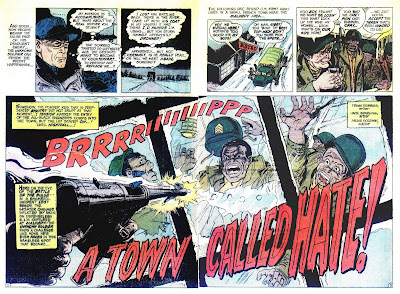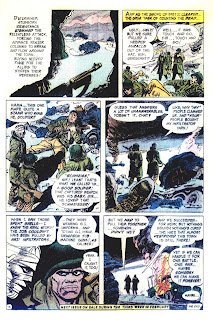With Archie Goodwin as editor, this issue of Star Spangled War Stories (179, March 1974) features an Unknown Soldier story that exposes the intense racial infighting that had been a serious problem in the U.S. military during the Vietnam conflict, using a WWII setting. In the Armed Forces Journal in 1971, Col. Robert D. Heinl, Jr. wrote:
"The morale, discipline and battleworthiness of the U.S. Armed Forces are, with a few salient exceptions, lower and worse than at any time in this century and possibly in the history of the United States. By every conceivable indicator, our army that now remains in Vietnam is in a state approaching collapse, with individual
units avoiding or having refused combat, murdering their officers and non commissioned officers, drug-ridden, and dispirited where not near mutinous. Elsewhere than Vietnam, the situation is nearly as serious. Intolerably clobbered and buffeted from without and within by social turbulence, pandemic drug addiction, race war,
sedition, civilian scapegoatise, draftee recalcitrance and malevolence, barracks theft and common crime, unsupported in their travail by the general government, in Congress as well as the executive branch, distrusted, disliked, and often reviled by the public, the uniformed services today are places of agony for the loyal, silent professionals who doggedly hang on and try to keep the ship afloat."
Col. Heinl paints an extremely disturbing picture. He points out, "It is a truism that national armies closely reflect societies from which they have been raised. It would be strange indeed if the Armed Forces did not today mirror the agonizing divisions and social traumas of American society, and of course they do." It's easy to forget (for those of us who lived through the period) how troubled society was at the time, as the so-called 'Swinging Sixties' gave way to the disillusionment of the 1970s.
He goes on to say, "Internally speaking, racial conflicts and drugs... are tearing the services apart today."
The Colonel provides examples of racial troubles within the military, both in Vietnam and elsewhere. While it seems clear that the eruptions of actual racial violence usually but not always originated with the African American personnel, there is no discussion of any racist treatment which might have provoked such outbreaks, but of course one has to assume that at some point this existed, if not in the moment then historically. Col. Heinl writes:
"Racial conflicts (most but not all sparked by young black enlisted men) are erupting murderously in all services...As early as July 1969 the Marines (who had previously enjoyed a highly praised record on race) made headlines at Camp Lejeune, N.C., when a mass affray launched by 30-50 black Marines ended fatally with a white corporal's skull smashed in and 145 other white Marines in the sick bay...Even the cloistered quarters of WACs have been hit by racial hair-pulling. In one West Coast WAC detachment this year, black women on duty as charge-of-quarters took advantage of their trust to vandalize unlocked rooms occupied by white WACS. On this rampage, they destroyed clothing, emptied drawers, and overturned furniture of their white sisters."
There is little in the Colonel's report in terms of reassurance, but he does observe, "All services are today striving energetically to cool and control this ugly violence which in the words of one noncommissioned officer, has made his once tough unit divide up "like two street gangs.""
He finishes his entire piece with a general observation on all the factors he has described that were contributory to the dire situation in the military, of which racial in-fighting was admittedly only one aspect, albeit a major one: "...many a thoughtful officer would be quick to echo the words of BGen. Donn A. Starry, who recently wrote, "The Army can defend the nation against anything but the nation itself." Or -- in the wry words of Pogo -- we have met the enemy, and they are us."
Three years after Col. Heinl wrote that frightening assessment of the state of affairs in the military, the problem was clearly still in the public consciousness, and became the subject of this Unknown Soldier story, "A Town Called Hate!", written by Frank Robbins and illustrated beautifully by Jack Sparling.
When a segregated African American unit comes into town and meets a segregated white unit in the local eatery, the racial tension level spikes through the roof. That night, some soldiers in the all African American unit are mercilessly gunned down, by an assailant whose identity is unknown to the reader at this point.
After what went on earlier, the African American soldiers are in no doubt as to who the perpetrators of these murders are, and exact their own fatal revenge:
The Unknown Soldier already has a mission, but once the news of the racial conflict amongst the troops reaches headquarters, it looks like he's going to have another task. The exchange between the African American sergeant, the Unknown Soldier's aide, Chat Noire, and his commanding officer reveals racial tension present at all levels in the ranks.
For the time being, however, and very ironically, the racial conflict works in favor of the U.S. forces. The group of Nazis disguised as G.I.'s, that the Unknown Soldier has infiltrated, reaches the town. Still seeking vengeance, the African American unit mistakes the Germans for the hostile white U.S. soldiers. In taking them prisoner they find out they're Nazis, and also that they've contacted the Unknown Soldier.
Chat Noire rolls into town in the nick of time to quell the racial conflict amongst the U.S. troops. Evidence then emerges that appears to indicate that disguised Nazis shot the African American soldiers, hoping to divide the Americans against each other. Sufficient unity is recreated to turns everyone's attention to the Nazi onslaught, and succeed:
While the point has been made that racial divisions in the military are counterproductive to the mission of our armed forces, there's a kind of disturbing epilogue that only the Unknown Soldier and Chat Noire are party to. In surveying their dead after the battle, the corpse of one white soldier is found, still clutching the German weapon he'd captured, used as his own, and which had become a kind of trademark lending it's name to him as a nickname. Those German cartridge cases found at the scene of the initial crime that sparked the racially polarized battle within the U.S. forces now take on more meaning. The white unit bought the Nazi infiltrator explanation because they knew it really was one of their men who carried out the shooting. The African American unit were convinced by the evidence that they had been hoodwinked by the Nazis. But the real truth was that it had been a racist white soldier who had gunned down his African American comrades in cold blood, and the engineers' initial deductions had been correct. For the sake of the war, the problem was solved temporarily, but the racial divisions still existed.
This story picked up on this racial conflict in the military theme that had originally been brought to light in comics by Harvey Kurtzman and Ric Estrada's "Bunker!" in Two-Fisted Tales 30 (Nov-Dec 1952), from over 20 years earlier. According to Col. Heinl, racial conflict within the U.S. military had a long history, dating back to the beginning of the 20th century. He noted, "Racial trouble is no new thing for the Army. In 1906, after considerable provocation, three companies of the 25th Infantry (a colored regular regiment) attacked white troops and townspeople of Brownsville, Texas, and had to be disbanded. Among the few pre-World War II War Department records still heavily classified and thus unavailable to scholars are Army documents
on racial troubles."America's struggle for racial equality and integration has, on the one hand, been a source of criticism of the American people. But looked at another way, and I would say a more accurate way, it is the struggle of a nation at the forefront of developing a more enlightened, more advanced civilization. This struggle is seen in America because it is here where racism has been challenged by both white and black, and where the fight is on the front line. Where America has already trodden, other countries have yet to follow. While there are undoubtedly many areas of progress still to be made, I would argue that there is no nation on Earth that has advanced as far as the USA in developing a harmonious multi-racial, multi-cultural society, despite whatever shortcomings we still have to address. Comics like this issue of Star Spangled War Stories, that bring important issues out into the open, have played their part in the progress that has been made.
















No comments:
Post a Comment
Note: Only a member of this blog may post a comment.